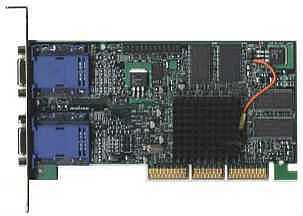Conclusions
 I
have to keep reminding everyone that this is a video card that was designed
for the business market. In that market stability, 2D image quality and
performance, and maximum resolution rule. What Matrox has done by bringing
the G450 into the home arena is let home users have access to a card that
would be great for a home business user or a professional who needs similar
quality to their office computer. Let's breakdown the G450 into a few subcategories:
I
have to keep reminding everyone that this is a video card that was designed
for the business market. In that market stability, 2D image quality and
performance, and maximum resolution rule. What Matrox has done by bringing
the G450 into the home arena is let home users have access to a card that
would be great for a home business user or a professional who needs similar
quality to their office computer. Let's breakdown the G450 into a few subcategories:
2D
Image Quality: There is no comparison for Matrox's 2D image quality.
They built their reputation on it and the G450 doesn't disappoint. Spend
all day looking at spreadsheets or word processing? Then you are the type
of person who would notice the 2D image quality of the Millennium G450 immediately.
3D Gaming Performance:
This is decidedly not the G450's forte. The 3D Mark score screams of a situation
where some work with the drivers could go a long way into increasing the
score. But that's just it, 3D Mark 2000 is a synthetic benchmark and many
a company are going out of their way to tweak their drivers to get a high
score. I think Quake III Arena is a more representative example of the performance
that users can expect from the G450. At low to middle resolutions you can
expect a good gaming experience, especially with a fast processor in your
machine. If gaming is your absoulte measure of a card's performance then
by all mean look elsewhere. I think that some newer drivers and the inclusion
of an overclocking utility would go a long way to help the Millennium G450
in this area.
DualHead Technology:
This is THE reason to buy the G450. The versatility of having a second CRT,
TV, or LCD display to move your work to is a great aid in productivity.
Other cards allow a second display output, notably cards based on the nVidia
GeForce 2 GTS or MX core. What most of those cards lack is the flexibility
to use a television or flat panel as your second display as they usually
require another device to convert the signal into a format that can be used
by a television or LCD. Matrox took care of all of those hassles by building
all the components into the card and shipping a dongle cable for television
use with the card.
DVD Software Decoder:
I've used quite a few DVD decoders and this one stands out for its performance
and ease of use. I tried my best to hurt the playback performance of the
decoder by running all sorts of CPU intensive programs in the background
and by messing around with its settings during playback. There were no dropouts
and I was very happy with its playback of several DVDs. The layout of this
software player is similar to other software players I've used, but its
optimized performance with this card makes it a valuable inclusion.
Bundled Software:
Yet another strong point for the G450. Matrox included Picture Publisher
and Simply 3D, both of which are valuable products for people looking to
create 3D images or to edit existing images. I was impressed with the large
amount of gaming demos thrown in. Don't have any current software that will
utilize the EMBM (Environmental Bump Mapping) or DualHead technology of
the Millennium G450? You do now - right out of the box. Matrox even has
a patch on the CD for Dungeon Keeper 2 that will enable EMBM.
 So
what's the final verdict? I don't think that any card out their has the
flexiblity of the Millennium G450. There are plenty of cards out there that
can outperform it - but I wouldn't want to have to do a lot of work in front
of them. I've used this card extensively for a few weeks now and I am a
pig in mud when it comes to its 2D image quality. If you spend a lot of
time performing word processing, HTML coding, database entry, or spreadsheets
then this is the card for you. The fact that you get awesome DVD playback
and some decent 3D gaming with it certainly doesn't hurt either. At only
$145 I find this a more useful video card than many of the $400 cards that
only beat the G450 in 3D gaming performance.
So
what's the final verdict? I don't think that any card out their has the
flexiblity of the Millennium G450. There are plenty of cards out there that
can outperform it - but I wouldn't want to have to do a lot of work in front
of them. I've used this card extensively for a few weeks now and I am a
pig in mud when it comes to its 2D image quality. If you spend a lot of
time performing word processing, HTML coding, database entry, or spreadsheets
then this is the card for you. The fact that you get awesome DVD playback
and some decent 3D gaming with it certainly doesn't hurt either. At only
$145 I find this a more useful video card than many of the $400 cards that
only beat the G450 in 3D gaming performance.
Victor
Oshiro January 17,2001
